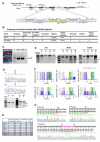TALEN-mediated gene mutagenesis in rhesus and cynomolgus monkeys
- PMID: 24529597
- PMCID: PMC4024384
- DOI: 10.1016/j.stem.2014.01.018
TALEN-mediated gene mutagenesis in rhesus and cynomolgus monkeys
Abstract
Recent advances in gene editing technology have introduced the potential for application of mutagenesis approaches in nonhuman primates to model human development and disease. Here we report successful TALEN-mediated mutagenesis of an X-linked, Rett syndrome (RTT) gene, methyl-CpG binding protein 2 (MECP2), in both rhesus and cynomolgus monkeys. Microinjection of MECP2-targeting TALEN plasmids into rhesus and cynomolgus zygotes leads to effective gene editing of MECP2 with no detected off-target mutagenesis. Male rhesus (2) and cynomolgous (1) fetuses carrying MECP2 mutations in various tissues including testes were miscarried during midgestation, consistent with RTT-linked male embryonic lethality in humans. One live delivery of a female cynomolgus monkey occurred after 162 days of gestation, with abundant MECP2 mutations in peripheral tissues. We conclude that TALEN-mediated mutagenesis can be an effective tool for genetic modeling of human disease in nonhuman primates.
Copyright © 2014 Elsevier Inc. All rights reserved.
Figures


References
-
- Amir RE, Van den Veyver IB, Wan M, Tran CQ, Francke U, Zoghbi HY. Rett syndrome is caused by mutations in X-linked MECP2, encoding methyl-CpG-binding protein 2. Nat. Genet. 1999;23:185–188. - PubMed
-
- Chan AW, Chong KY, Martinovich C, Simerly C, Schatten G. Transgenic monkeys produced by retroviral gene transfer into mature oocytes. Science. 2001;291:309–312. - PubMed
-
- Chen Y, Niu Y, Ji W. Transgenic nonhuman primate models for human diseases: approaches and contributing factors. J. Genet. Genomics. 2012a;39:247–251. - PubMed
-
- Chen Y, Niu Y, Yang S, He X, Ji S, Si W, Tang X, Xie Y, Wang H, Lu Y, Zhou Q, Ji W. The available time window for embryo transfer in the rhesus monkey (Macaca mulatta). Am. J. Primatol. 2012b;74:165–173. - PubMed
-
- Cho SW, Kim S, Kim JM, Kim JS. Targeted genome engineering in human cells with the Cas9 RNA-guided endonuclease. Nat. Biotechnol. 2013;31:230–232. - PubMed
Publication types
MeSH terms
Substances
Grants and funding
LinkOut - more resources
Full Text Sources
Other Literature Sources
Molecular Biology Databases
